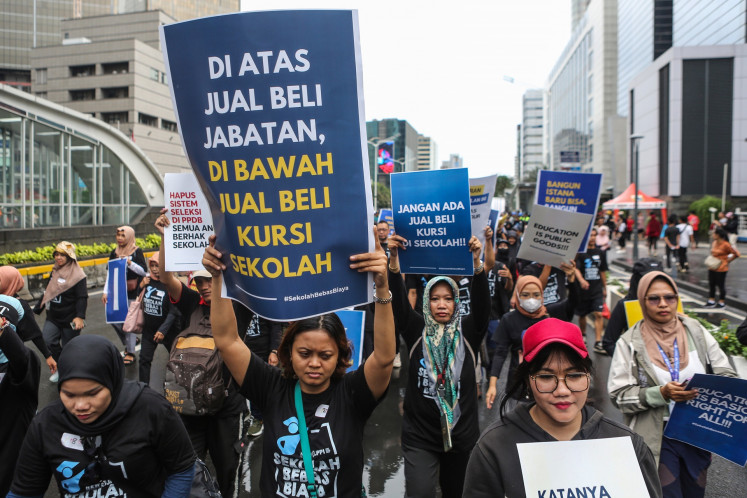Counting economic losses from disasters
Over the coming years, trillions of dollars of new business investment are set to pour into hazard-exposed regions of the world
Change text size
Gift Premium Articles
to Anyone

O
ver the coming years, trillions of dollars of new business investment are set to pour into hazard-exposed regions of the world. How the private sector ' accounting for up to 85 percent of this total investment ' decides to allocate these funds will largely determine whether economic losses from disasters will continue
to escalate.
It will also have a considerable bearing on whether or not we can save lives, jobs and property and reduce the number of people affected by disasters each year which currently averages over 200 million.
The United Nations' 3rd Global Assessment Report on Disaster Risk Reduction reveals that economic losses from disasters are simply out of control.
A review of new data by the UN Office for Disaster Risk Reduction indicates that the direct economic losses from disasters so far this century are 50 percent higher than previous estimates: in the range of a massive US$2.5 trillion.
In a time of global financial crisis, it is remarkable how few companies have combined enhanced information on potential disruptions, supply chain and financial impacts with disaster simulations, to better understand risk drivers and the geographical concentration of risk in order to strengthen their supply chain management.
Globalized supply chains have created new vulnerabilities. In the wake of the 2011 Japan earthquake, automobile giant Toyota lost $1.2 billion in product revenue. Parts shortages in the US caused 150,000 fewer vehicles to be manufactured. Production in India and China dropped 70 percent and 50 percent respectively.
A survey undertaken for this report of 1,300 SMEs in the Americas found that only 14.2 percent of companies with less than 100 employees had a business continuity plan or crisis management program. An estimated 25 percent of businesses close their doors after a catastrophic event.
This disturbing reality is not surprising given the overall lack of attention paid to disaster risk management in business schools and by economic analysts and forecasters. Currently, insurance pricing does not reflect risk levels or provide an adequate incentive for risk sensitive business investment.
Earthquake resistance may be the most important criteria for choosing new offices for 92 percent of businesses in Japan but population growth is fuelling a new wave of urbanization in hazard-exposed countries where a culture of resilience has yet to take hold.
Investment in disaster risk reduction has obvious benefits for many small island developing states whose economies are fragile and exposed to the elements. The competitiveness of these countries and the hotel chains and others investing in them, will depend on cost-effective risk reduction.
Agribusiness must be another area of concern. Current practice is adding to global food insecurity. Over two million hectares of land have been acquired through international agribusiness investment in drought-prone countries like Ethiopia. Commodity markets, biofuel production, increasing demand and low stocks can transform production shortfalls due to drought into global food price spikes.
Disasters directly affect business performance and undermine longer-term competitiveness and sustainability. And when business leaves, it may never return. Prior to the 1995 Kobe earthquake, the city's port was the world's sixth-busiest. Despite a massive investment in reconstruction and efforts to improve competitiveness, by 2010, it had fallen to 47th place.
Many companies report that indirect costs are often higher than direct losses. The same business survey in the Americas recorded disruptions to power, water and telecommunications as the top concerns. More than 90 percent of the damage to these business lifelines occurs in local disasters that are rarely reported in the wider media.
When business is interrupted, skilled workers may leave, market share can be lost, relationships with suppliers and partners are jeopardized and reputations can be damaged. Once business is lost, it's often slow to return if it returns at all.
Encouragingly, there is growing evidence that businesses, particularly global corporations, are starting to pay more attention to disaster losses and to strengthen risk management in this regard.
And, indeed, the business case for stronger disaster risk management ' rather than simply business continuity planning ' is compelling. New Zealand electricity networker Orion invested $6 million in seismic protection measures that saved the company $65 million in the wake of the 2010 and 2011 Christchurch earthquakes.
Mexican fishermen whose livelihoods were devastated by Hurricane Isidore made preventive investments that saved each individual entrepreneur an average of $35,000 after Hurricane Wilma three years later.
It also provides an avenue for business to make money. The market for climate change adaptation is estimated at $100 billion a year until 2050; a huge opportunity for business. The 'green building' sector, earthquake resistant construction, climate change adaptation and crop insurance products are all examples of emerging markets.
Embedding disaster risk management in business processes is key to resilience, competitiveness and
sustainability.
The theme will feature strongly at this week's Global Platform for Disaster Risk Reduction, in Geneva, where 3,000 participants will debate the shape of a revised international framework for disaster risk reduction which must put the private sector at the centre of our efforts to mitigate and prepare for the shocks and crises of the coming century.
The writer is the special representative of the UN Secretary-General for Disaster Risk Reduction.









